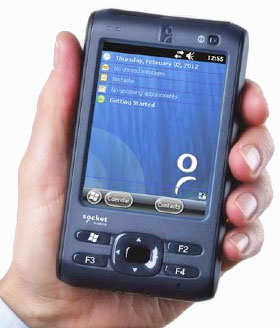|
Socket SoMo 655 Handheld Computer
A slightly updated version of Socket's legacy Pocket PC/PDA for those who don't need or want a smartphone
(by Conrad H. Blickenstorfer)
A few years ago, Socket Mobile, a longtime provider of mobile productivity solutions, realized that the market for its various add-on expansion cards was drying up because, for the most part, their functionality was increasingly included in newer products. Socket's response was twofold. First, they revamped their peripherals lineup, ditching older products that were no longer needed, and adding future-oriented peripherals such as scanners and other data capture modules. Second, they created their own handheld computer, the SoMo 650, initially as an ongoing host for their own line of peripheral cards, and then increasingly as an up-to-date replacement for legacy PDAs and Pocket PCs (such as the HP iPAQ).
 What that means is that the Socket SoMo never competed with smartphones. The SoMo handhelds did not try to emulate the iPhone and, later, Android devices with their capacitive touch screens and app-oriented interfaces. Instead, the SoMo simply perpetuated the Windows Mobile based Pocket PC the way Microsoft envisioned it in the early 2000s. Everyone knows how that turned out for Microsoft: while the Pocket PC battled Palm for supremacy in a comparatively small market, smartphones took off and left the conventional PDA in the dust and for dead. What that means is that the Socket SoMo never competed with smartphones. The SoMo handhelds did not try to emulate the iPhone and, later, Android devices with their capacitive touch screens and app-oriented interfaces. Instead, the SoMo simply perpetuated the Windows Mobile based Pocket PC the way Microsoft envisioned it in the early 2000s. Everyone knows how that turned out for Microsoft: while the Pocket PC battled Palm for supremacy in a comparatively small market, smartphones took off and left the conventional PDA in the dust and for dead.
That, however, doesn't mean the market for such legacy PDA/Pocket PCs has completely gone away. Not everyone needs their handheld to be a phone that's chained to expensive two-year contracts with the telcos. In fact, given the anger at telcos and the emergence of tablets as much better purveyors of app functionality, it's surprising that the non-phone PDA market hasn't seen more of a resurgence.
The legacy aspect of the SoMo project, however, does not mean Socket's handheld is completely frozen in time. The original SoMo 650 spawned specialized versions for promising markets that also did not require phone functionality, such as healthcare (the SoMo Rx) and hi-security environments (the SoMo DXS). And in early 2012, Socket announced an updated version of the SoMo 650 platform, the SoMo 655.
What's new and different with the SoMo 655? Fans of the platform need not worry that Socket caved and morphed the SoMo into a smartphone. The new version remains a traditional Pocket PC/PDA, but with slightly updated technology and functionality. Here's an overview of what's changed:
- Windows Mobile 6.5 Classic, now known as Windows Embedded Handheld 6.5, replaces the older Windows Mobile 6.1. The newer version is a bit friendlier and adds a bit of functionality, but largely retains the traditional WinMo look and feel.
- With vast amounts of storage now common, the SoMo 655 gets a boost from 256MB to 4GB of Flash (and you can still add up to 32GB via cards, but it's now microSD and no longer SD).
- WiFi is now the faster 802.11b/g/n instead of just b/g (but Bluetooth is still version 2.0).
- There's now a vibrate alarm, new chargers and cradles that can accommodate SoMos even with their DuraCase, and there's an optional 3-year warranty.
That about is it for newness. The 624MHz PXA270 processor stays, as does the 240 x 320 pixel QVGA display, and the look and feel hasn't changed either. The Socket Mobile 655 remains a "traditional" handheld computer that still looks like a PDA and not like a phone on steroids. It measures 5 x 2.95 x 1.0 inches and weighs just over seven ounces. It has a 3.5-inch LCD display, a 5-way navigation button flanked by two application bottons on each side, a 3.7 Volt/2,600mAH Li-Ion battery, a hands-free headset microphone connector, and the Compact Flash and micro-SD card slots.
On the software side, Embedded Handheld 6.5 comes with Outlook Mobile, IE Mobile, MSN Messenger and numerous utilities. Client synchronization is via ActiveSync / Windows Mobile Device Center Client, and there's the Windows Media Player Mobile. The .NET Compact Framework v3.5 is also installed. There is also a slew of Socket-specific applications, including SocketScan for barcode, magnetic stripe reader, RFID and UIC683 Smart Cards. Socket also offers special software development kits for data collection and wireless LAN applications.
As before, the new SoMo comes in standard, Rx healthcare, and DXS hi-security versions. And as before, its target market is the many applications that either simply don't need phone functionality or advanced ruggedness, and the still numerous applications where the Socket handheld can replace aging and/or discontinued Pocket PCs/PDAs such as the HP iPAQ.
|



